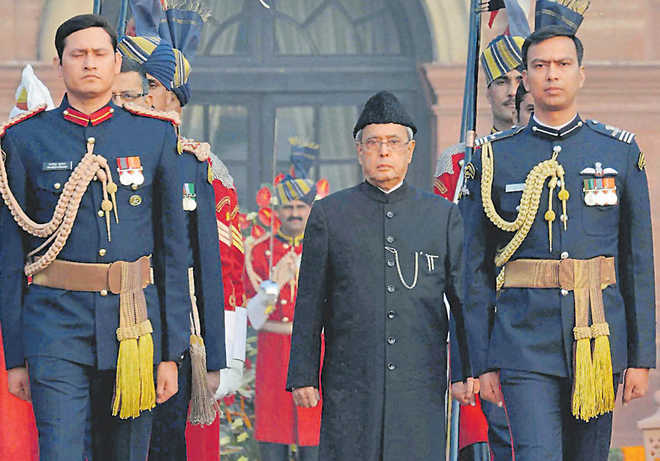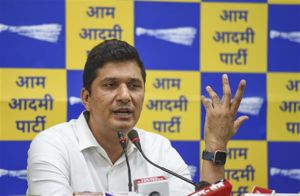
Figurehead: A President should guide, and offer a ‘counter helm’.
Gopalkrishna Gandhi
THREE days from today, India will celebrate yet another Republic Day. The anniversary of the day when India became a Republic is, above all else, the President’s day. He unfurls the national flag, takes the salute at a parade where the armed forces of India march past him, places medals on the chests of gallant soldiers, awards eminent civilians with Padma awards. And on the eve of all the festivities, speaks to the nation.
In brief, the President occupies centre-stage on Republic Day. He is, indeed, the very symbol of the Republic of India. Figurehead he may be, but the figurehead glows that day.
More interestingly though, less explicitly, Republic Day is also the day when the PM of the day takes a backseat. Literally and metaphorically. A look at the first Republic Day is revealing.
President Prasad’s swearing-in on our first Republic Day in 1950, was a moment of great magnetism and great meaning. For one thing, he commanded huge respect. For another, he was inaugurating the office. He was the first first citizen, his was the inaugural inauguration. As the new Constitution came into force, we had two forceful personalities at India’s helm — a sagacious head of state, Prasad, and a charismatic head of government, Nehru.
But beneath these great causes of jubilation lay an interesting and highly meaningful political circumstance: Prasad was not Nehru’s first preference for the post. But the Congress was clear: It had to be him. Sardar Patel, in particular, was for Prasad. And so the first President came upon his office on a power engine of his own. One which, at that point, outdid the power engine of the PM and PM Nehru at that.
Did that lead to two power centres? No, it did not. The innate civility of both the President and the PM would not allow that, nor their understanding of their respective roles. The President’s was a symbolic office, the PM’s the substantive one. And yet there were occasions when the two power engines rumbled differently. President Prasad raised the question of presidential prerogatives, presidential discretion. Article 74 of the Constitution spoke of the President acting on the advice of the council of ministers headed by the PM. How binding, Prasad wondered aloud, was the advice of the Cabinet?
Attorney-General MC Setalvad’s view was sought and came ringingly clear: The President is like the British monarch, a constitutional, not an executive head, and has to be guided by Cabinet advice. The point of presidential prerogatives was not pressed by the President. But it was enough that it had been made.
Setalvad’s position was reiterated forcibly and conclusively in 1975 when, in a landmark judgment, the Supreme Court confirmed this position. Setalvad and Shamsher Singh and Another vs the State of Punjab have settled the point.
No President has flouted Setalvad’s opinion, but no President has forgotten Prasad’s doubt. We have had, counting from President Prasad, 13 Presidents in 14 presidencies, Prasad having had two consecutive terms. Eleven of them men, and one, woman. Ask any regular Indian to name any one: From the historically inclined, certainly, you will hear ‘Rajendra Prasad’. In scholarly circles, ‘Radhakrishnan’. But by and large, in the towns and even villages, only one name of a President will be recalled ‘like that’: APJ Abdul Kalam. Power is one thing, impact another. Kalam imprinted himself on the minds of the people by being different. His cut of hair, his open collar, crinkled pants only sharpened his original, easy nature. There have been far greater Presidents than he, but Kalam brought his office out of the cage of protocol. More than anything else, he offered a counter helm. Not a combative counter, not a competitive counter, but a counter. Counter to who or what? Not to the PM or to the Cabinet but to the political narrative. A PM has to be, and is, about politics. A President has to be, and is, about nationhood. A PM has to be, and is, about our democracy. A President has to be, and is, about our Republic.
Irrespective of where they have come from, what their religion is, or language, their politics or their sociology, our Presidents have gone by the Setalvad opinion. Some of them have been so very, very constitutional as to have become dust in the book’s innermost lining. No one misses anything by forgetting them. But some have provided the counter helm, not as dramatically as Kalam, but nonetheless, effectively. Exercising what Walter Bagehot described as the right to be consulted, to warn and to encourage, they have obliged the PM of the day to come to them, explain proposals, defend and justify them and then return to either change the proposal or to reiterate it with modifications.
Our second President, Sarvepalli Radhakrishnan, saw India through three Prime Ministers — Nehru, Shastri and Indira Gandhi. The PM was the mind of the nation as a state, the President was the soul of the state as a nation. The PM led, the President guided. The PM took decisions, the President influenced thought. The PM advised the President, the President shaped that advice by virtue of his personality. The PM commanded the majority in the Lok Sabha, the President commanded the respect of the Lokasangraha.
And he warned. Not just as a right, but as a duty. In his last Republic Day address, in 1967, he warned the country and the government that: ‘We cannot forgive widespread incompetence and the gross mismanagement of our resources’. Indira Gandhi was not pleased. But the nation was sobered. President KR Narayanan crafted his addresses with great deliberation, speaking directly and with tremendous impact. In his address on the eve of the Republic Day, 2000, he said to his government: ‘Beware of the fury of the patient and long-suffering people’.
Speeches are speeches are speeches, one might say. What do they change? We may be surprised. They grind, like justice, subtly, but they grind exceeding small. A President’s speech, if it comes not from some calculating intelligence, some crafty agenda, but from a clean soul, can grind political egos down and lift the nation’s spirits.
Politically, the President is weightless; inspirationally, he can weigh a ton. The PM is the ink on a Cabinet note which expires; the President is the carving on our nationhood which inspires. The President gives to what is strong, stature; to what is powerful, sanctity. On Republic Day, this year, the last of his five, may we receive from President Pranab Mukherjee, no cliché, nothing that is trite, but that of which President Rajendra Prasad, President Radhakrishnan and President Narayanan will be proud.
The writer is a former Governor of West Bengal



























